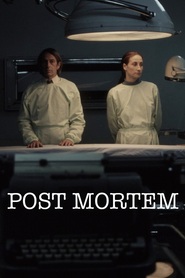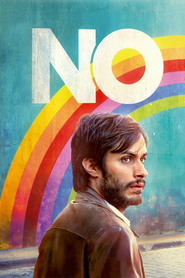 Tony Manero (Pablo Larrain, Chile, 2008, 98 min)
Tony Manero (Pablo Larrain, Chile, 2008, 98 min)
UW Cinematheque, Sat Feb 22, 4pm»
Raul, a 50 year-old man, is obsessed with Saturday Night Fever (1977). His life revolves around this film and becoming John Travolta. When a local TV show announces a contest to find the Chilean Tony Manero, Raul finally sees the opportunity to elevate into show business. In what seems like a the classic story of rags to riches, this film instead effectively supplies a realistic example of someone selfishly holding onto a single fantasy while living under strict fascist control.
Ignorantly, I went into Tony Manero thinking that it’d be a humorous tribute to a classic 70’s disco movie. Instead, the film takes place in Chile in 1978 under the dictatorship of Augusto Pinochet and is an honest, yet depressing, depiction of a heartless man obsessed with an unorthodox dream. Raul is willing to do anything in his limited power to get even a taste of the fantastical dream of being Tony Manero. Everything he does is in attempt to replicate Saturday Night Fever. He has learned every dance move and he spends his nights and weekends practicing them with a small group of dancers in a local bar. He doesn’t have a job otherwise. When asked what he does for a living, he answers, “this”, meaning dancing.
To be fair to Raul, there are similarities between John Travolta’s Tony Manero and Raul. They are both stuck in dead-beat existences hoping to find a way to stardom. They are also both beloved as dancers by their community. However, talent, age, and the societal conditions are vastly different between the two.
The group of dancers that perform with him include Cony, Wilma (Cony’s daughter) and a young man named Goyo. All of them, along with the bar owner Pauli, idolize Raul. And all three of the women even proposition him several times throughout the film, creating a strange sexual dynamic within this close group. Raul, however, holds no love or patience for any of these characters and in fact easily hurts them without a bit of remorse. When Raul’s crimes finally catch up to him, he immediately sneaks away leaving this group to answer for the accusations made by the fascist government.
I know I write with a hint of sarcasm when describing Raul and his dream, but the film in no way handles Raul’s life as a parody. The honest depiction of this dictator-ruled society and a soulless main character is unusual compared to the majority of films who’s protagonist holds at least one redeeming quality. The man we follow is lifeless and only able to obtain pleasure from a Hollywood fantasy. He is detached from all other aspects of the world around him. He is unsympathetic to the people he encounters and is reckless with their admiration and love. We don’t sympathize with Raul or even root for him. Tony Manero proves that thinking positively of the main character is not always necessary for a film to be effective. Though the raw brutality is hard to watch at times, I was still moved by the film and wanted to know what happened in the end.
In order to adequately convey Raul’s obsession with Saturday Night Fever and the resulting cruelty, I have to mention one of his crimes. Throughout the film, Raul attends the local movie theater three times. In the first time we see Raul attend a showing of Saturday Night Fever he is alone in the audience and dances along with John Travolta. He then sits in the middle of the rows of seats, the back of his head centered in the foreground and Saturday Night Fever surrounding his head in the background. We can hear Raul repeating the words slightly after they are stated onscreen. I think the only English Raul knows is what he has picked up watching this movie, including the pick up lines that he tries out on both Cony and Wilma.The second visit to the theater is similar, he walks in dancing, strutting along with the disco music and repeats the lines in the middle of the empty audience. The third time Raul goes to the theater Saturday Night Fever isn’t playing and the lady at the ticket booth suggests that he watches Grease instead. He agrees, walks into the theater but right when he sees John Travolta in a tight red shirt that says Rydell High across the front, he immediately walks out. Raul then goes up the stairs to the projector room and smashes the projectionist’s head in.
There is a hint of this kind of irrational violence earlier, but it did not prepare me for this brutal reaction. Never is it explained why Raul is the way he is. It is only understood that he will not let anything come in the way of him and Saturday Night Fever. By concentrating on an angry man with no love or prospects, except for a irrational dream, and tying him in closely with the Pinochet dictatorship, Tony Manero effectively suggests that people are bad people, and perhaps produced by an unsympathetic and controlling society.
Tony Manero will be screening with Pablo Larrain’s Post Mortem and No! at the UW Cinematheque New Chilean Cinema series, all on Saturday, February 22. If you miss the UW Cinematheque screenings, Tony Manero is also currently streaming on Netflix View Instantly.
Also on Netflix is Larrain’s later feature, Post Mortem. His most recent feature, No!, is also available for purchase on various streaming resources.
Posters and Synopses from The Movie Database:
 Post Mortem (Pablo Larrain, Chile, 2010, 98 min)»
Post Mortem (Pablo Larrain, Chile, 2010, 98 min)»
In Chile, 1973, during the last days of Salvador Allende’s presidency, an employee at a Morgue’s recording office falls for a burlesque dancer who mysteriously disappears.
 No! (Pablo Larrain, Chile, 2012, 115 min)»
No! (Pablo Larrain, Chile, 2012, 115 min)»
In 1988, Chilean military dictator Augusto Pinochet, due to international pressure, is forced to call a plebiscite on his presidency. The country will vote ‘Yes’ or ‘No’ to Pinochet extending his rule for another eight years. Opposition leaders for the ‘No’ vote persuade a brash young advertising executive, Rene Saavedra, to spearhead their campaign. Against all odds, with scant resources and while under scrutiny by the despot’s minions, Saavedra and his team devise an audacious plan to win the election and set Chile free.